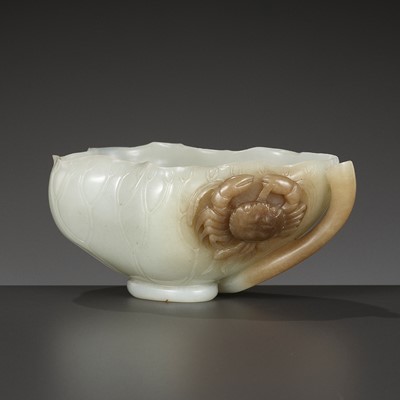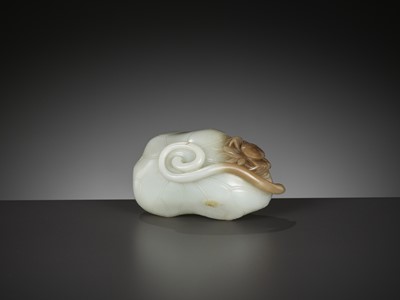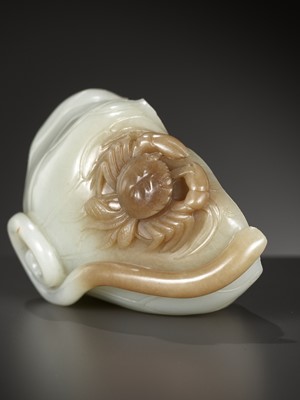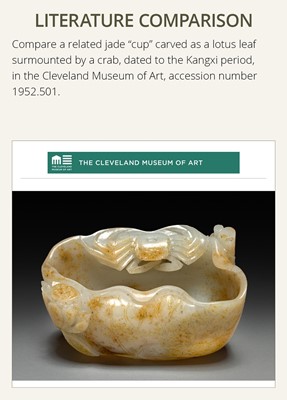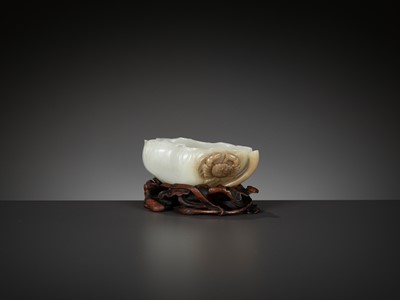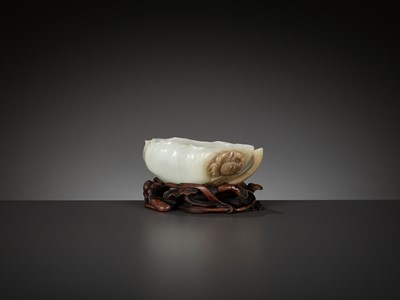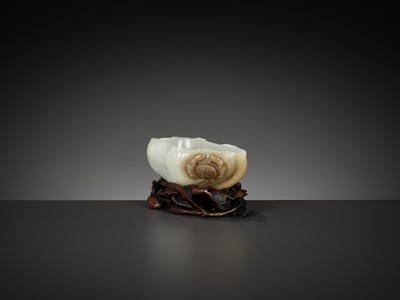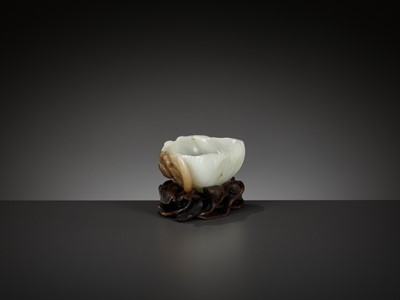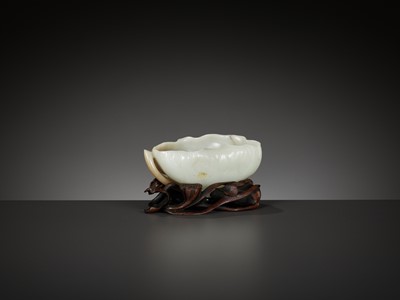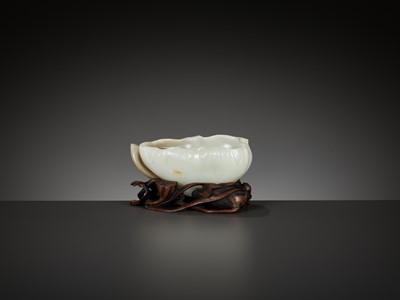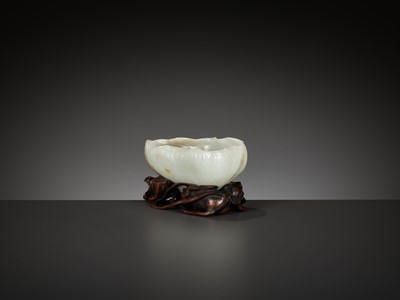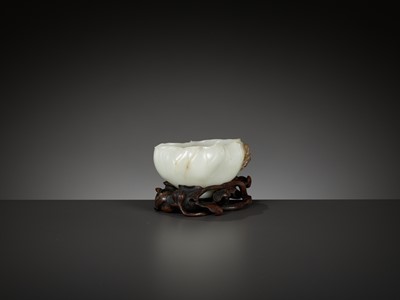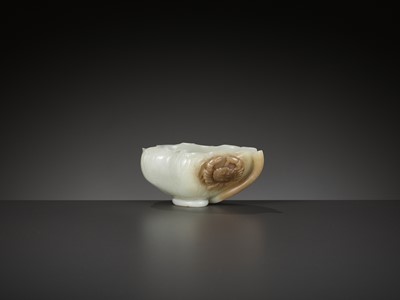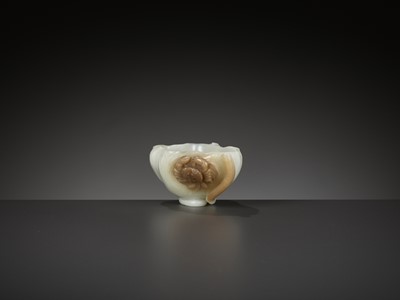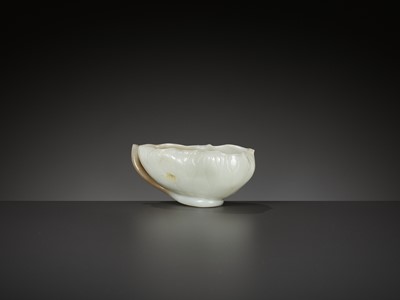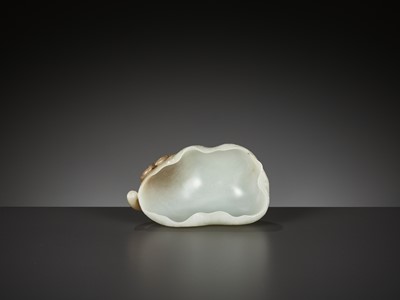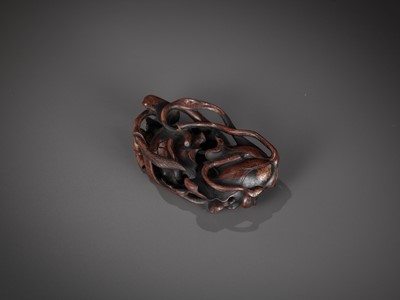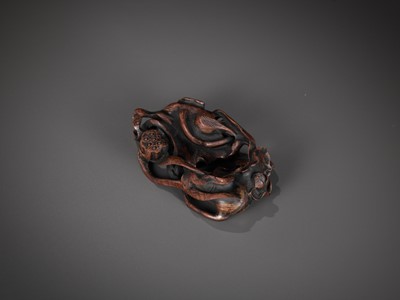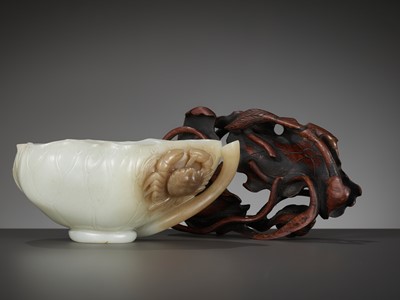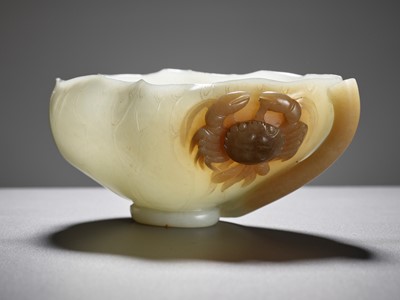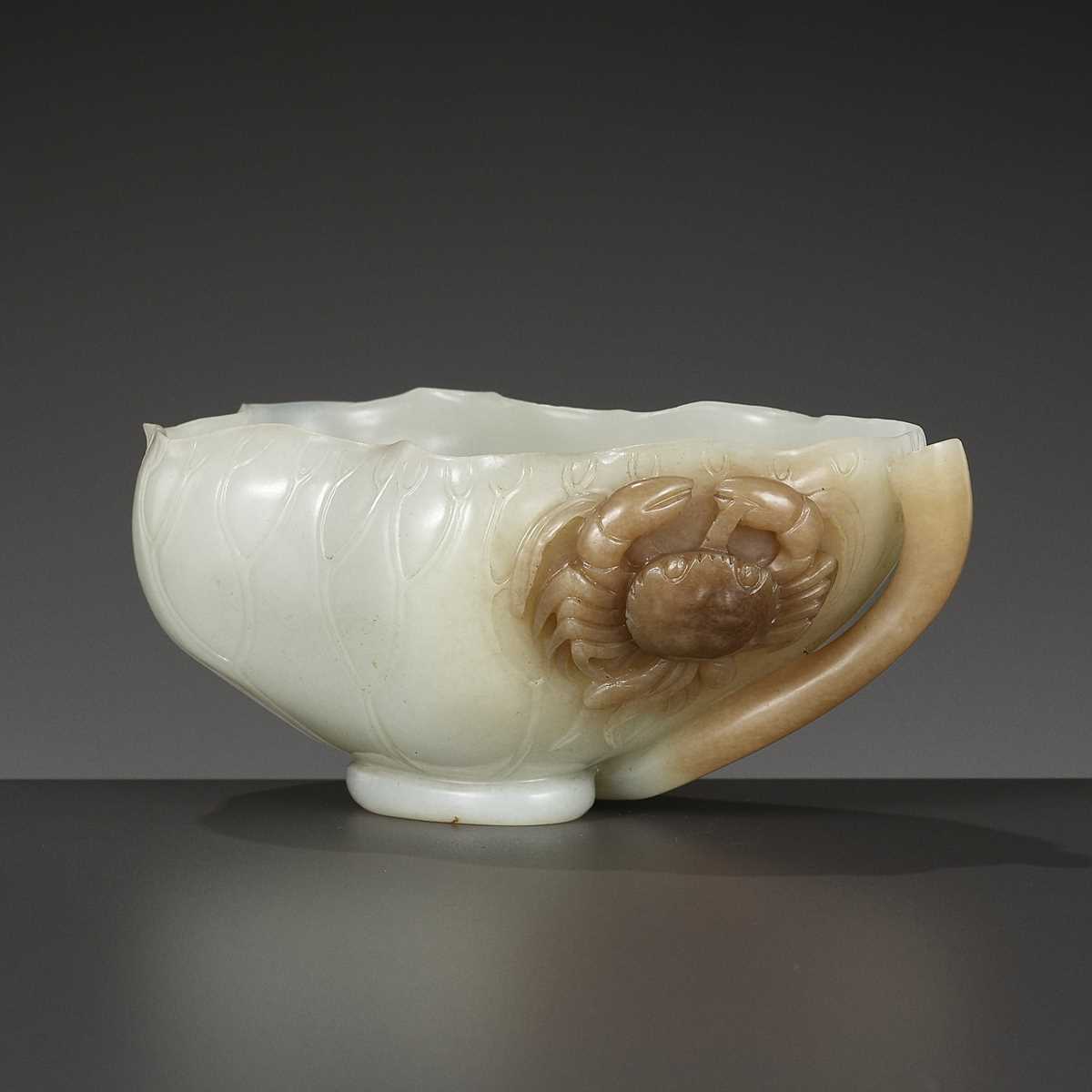9th Mar, 2023 13:00
TWO-DAY AUCTION - Fine Chinese Art / 中國藝術集珍 / Buddhism & Hinduism
47
A WHITE AND BROWN JADE ‘LOTUS, CRAB AND MILLET’ BRUSH WASHER AND MATCHING WOOD STAND, 18TH CENTURY
十八世紀白玉褐斑蓮葉筆洗
Sold for €6,500
including Buyer's Premium
China. Exquisitely carved as a furled lotus leaf, finely detailed with veins, the curled stem serving as the foot and handle of the vessel, one side carved with a clambering crab. The superbly polished translucent stone of a pure white tone with pale sugar brown shadings and few russet inclusions and veins.
Provenance: An old English private collection. A Hungarian private collection, acquired from the above.
Condition: Very good condition with minor wear and few tiny nibbles. The stone with natural fissures, some of which have developed into small hairline cracks over time. The wood stand with minor wear, few expected age cracks, and small losses.
Weight: 203.7 g (the washer) and 84.2 g (the stand)
Dimensions: Length 11 cm
The matching wood stand, probably huali, lacquered and finely carved in openwork as two lotus leaves borne on curled stems further issuing lotus pods and millet stalks. (2)
This brush washer is an exceptional example of the level of carving achieved by craftsmen in the 18th century. From the exquisitely detailed veins of the lotus leaf and modeling of the crab, to the fluid naturalistic form of the leaf, the carving has been expertly positioned and composed within the pebble to ensure minimal wastage and the clever incorporation of the brown portion of the stone to highlight the crab and stem.
Lotus-leaf brush washers and water droppers were popular from the Ming dynasty, and were produced in various materials including porcelain, agate, bronze and jade. Such vessels are an example of the ideal natural world that was miniaturized and brought into the scholar's studio. These perfect representations of nature, which encompassed a range of objects including boulder carvings, brush pots and brush washers, proved a means of inspiration and escape for the scholar who was caught in the day-to-day duties of officialdom. An old name in Chinese for crab was jia, a reference to the creature’s shell, and the word for lotus is lian.
Such scenes were also imbued with auspicious meaning. Together, the crab and lotus formed the rebus lian ke jia di, meaning ‘first place in consecutive examinations’. The lotus is also called hehua, and the common name for crab, xie, also combines to form the phrase hexia which means ‘harmony’.
Expert’s note: It is rare to find a brush washer in white and brown jade, as this combination of colors was usually reserved for figural jades. The lapidary has masterfully utilized the different shades of the stone and polished it to a high translucency to further heighten the awe-inspiring effect, and even added a matching stand which strikingly complements the depiction, altogether leaving no doubt that the present lot was made during the 18th century.
Literature comparison:
Compare a related jade “cup” carved as a lotus leaf surmounted by a crab, dated to the Kangxi period, in the Cleveland Museum of Art, accession number 1952.501.
十八世紀白玉褐斑蓮葉筆洗
中國。筆洗成捲曲荷葉形,葉紋清晰,卷莖為器足和柄,一側刻有小蟹。表面光滑,呈純白色,帶有淺棕色斑紋和少量赤褐色絮狀物及紋理。
來源:英國私人舊藏;匈牙利私人收藏購於上述收藏。
品相:品相極好,有輕微磨損,具有天然裂隙的石料,隨著時間的推移,其中一些已經發展成細小的裂紋。木架有輕微磨損,輕微老化裂縫,小缺損。
重量:203.7 克 (筆洗),84.2克 (底座)
尺寸:長11 厘米
配套的木架,可能是花梨木,上漆並精美鏤空,兩片荷葉承載在捲曲的莖上,其間可見蓮藕和花苞(2)
這件筆洗是十八世紀工匠雕刻傑出水平的典範。 從荷葉的精緻紋理和螃蟹的造型,到葉子的流暢自然形態,巧妙地定位和組合,以確保最大限度地減少浪費,並巧妙地融入石頭的棕色部分突出螃蟹和莖。
荷葉筆洗和水注流行於明代,材質多樣,包括瓷、瑪瑙、青銅和玉石。這些文房用具將自然山水縮小融入文人書房。這些對自然的完美再現,涵蓋了包括山子筆擱、筆筒和筆洗在內的一系列物品。螃蟹的中文舊名是甲,指的是這種生物的殼,蓮與螃蟹的場景也充滿了吉祥的意味。螃蟹又名“黃甲”,取這個“甲”字,螃蟹做雙數,取個“雙”字,意為“二甲連連”。一來,科舉考試中會將及第的甲科考生名字用黃紙寫在卷末,這就叫“黃甲”,和螃蟹同名。所以二甲連連和喜得連科是同一個意思。
專家注釋:很難找到白玉褐斑筆洗,因為這種顏色組合通常專用於人物造像。寶石工匠巧妙地利用玉料的不同深淺,將其打磨,更加上配套的支架,與畫面相得益彰,無不讓人認爲這件拍品是來自十八世紀。
文獻比較:
比較一件相近的康熙蓮葉螃蟹玉筆洗,收藏於Cleveland Museum of Art,館藏編號1952.501。
China. Exquisitely carved as a furled lotus leaf, finely detailed with veins, the curled stem serving as the foot and handle of the vessel, one side carved with a clambering crab. The superbly polished translucent stone of a pure white tone with pale sugar brown shadings and few russet inclusions and veins.
Provenance: An old English private collection. A Hungarian private collection, acquired from the above.
Condition: Very good condition with minor wear and few tiny nibbles. The stone with natural fissures, some of which have developed into small hairline cracks over time. The wood stand with minor wear, few expected age cracks, and small losses.
Weight: 203.7 g (the washer) and 84.2 g (the stand)
Dimensions: Length 11 cm
The matching wood stand, probably huali, lacquered and finely carved in openwork as two lotus leaves borne on curled stems further issuing lotus pods and millet stalks. (2)
This brush washer is an exceptional example of the level of carving achieved by craftsmen in the 18th century. From the exquisitely detailed veins of the lotus leaf and modeling of the crab, to the fluid naturalistic form of the leaf, the carving has been expertly positioned and composed within the pebble to ensure minimal wastage and the clever incorporation of the brown portion of the stone to highlight the crab and stem.
Lotus-leaf brush washers and water droppers were popular from the Ming dynasty, and were produced in various materials including porcelain, agate, bronze and jade. Such vessels are an example of the ideal natural world that was miniaturized and brought into the scholar's studio. These perfect representations of nature, which encompassed a range of objects including boulder carvings, brush pots and brush washers, proved a means of inspiration and escape for the scholar who was caught in the day-to-day duties of officialdom. An old name in Chinese for crab was jia, a reference to the creature’s shell, and the word for lotus is lian.
Such scenes were also imbued with auspicious meaning. Together, the crab and lotus formed the rebus lian ke jia di, meaning ‘first place in consecutive examinations’. The lotus is also called hehua, and the common name for crab, xie, also combines to form the phrase hexia which means ‘harmony’.
Expert’s note: It is rare to find a brush washer in white and brown jade, as this combination of colors was usually reserved for figural jades. The lapidary has masterfully utilized the different shades of the stone and polished it to a high translucency to further heighten the awe-inspiring effect, and even added a matching stand which strikingly complements the depiction, altogether leaving no doubt that the present lot was made during the 18th century.
Literature comparison:
Compare a related jade “cup” carved as a lotus leaf surmounted by a crab, dated to the Kangxi period, in the Cleveland Museum of Art, accession number 1952.501.
十八世紀白玉褐斑蓮葉筆洗
中國。筆洗成捲曲荷葉形,葉紋清晰,卷莖為器足和柄,一側刻有小蟹。表面光滑,呈純白色,帶有淺棕色斑紋和少量赤褐色絮狀物及紋理。
來源:英國私人舊藏;匈牙利私人收藏購於上述收藏。
品相:品相極好,有輕微磨損,具有天然裂隙的石料,隨著時間的推移,其中一些已經發展成細小的裂紋。木架有輕微磨損,輕微老化裂縫,小缺損。
重量:203.7 克 (筆洗),84.2克 (底座)
尺寸:長11 厘米
配套的木架,可能是花梨木,上漆並精美鏤空,兩片荷葉承載在捲曲的莖上,其間可見蓮藕和花苞(2)
這件筆洗是十八世紀工匠雕刻傑出水平的典範。 從荷葉的精緻紋理和螃蟹的造型,到葉子的流暢自然形態,巧妙地定位和組合,以確保最大限度地減少浪費,並巧妙地融入石頭的棕色部分突出螃蟹和莖。
荷葉筆洗和水注流行於明代,材質多樣,包括瓷、瑪瑙、青銅和玉石。這些文房用具將自然山水縮小融入文人書房。這些對自然的完美再現,涵蓋了包括山子筆擱、筆筒和筆洗在內的一系列物品。螃蟹的中文舊名是甲,指的是這種生物的殼,蓮與螃蟹的場景也充滿了吉祥的意味。螃蟹又名“黃甲”,取這個“甲”字,螃蟹做雙數,取個“雙”字,意為“二甲連連”。一來,科舉考試中會將及第的甲科考生名字用黃紙寫在卷末,這就叫“黃甲”,和螃蟹同名。所以二甲連連和喜得連科是同一個意思。
專家注釋:很難找到白玉褐斑筆洗,因為這種顏色組合通常專用於人物造像。寶石工匠巧妙地利用玉料的不同深淺,將其打磨,更加上配套的支架,與畫面相得益彰,無不讓人認爲這件拍品是來自十八世紀。
文獻比較:
比較一件相近的康熙蓮葉螃蟹玉筆洗,收藏於Cleveland Museum of Art,館藏編號1952.501。
Zacke Live Online Bidding
Our online bidding platform makes it easier than ever to bid in our auctions! When you bid through our website, you can take advantage of our premium buyer's terms without incurring any additional online bidding surcharges.
To bid live online, you'll need to create an online account. Once your account is created and your identity is verified, you can register to bid in an auction up to 12 hours before the auction begins.
Intended Spend and Bid Limits
When you register to bid in an online auction, you will need to share your intended maximum spending budget for the auction. We will then review your intended spend and set a bid limit for you. Once you have pre-registered for a live online auction, you can see your intended spend and bid limit by going to 'Account Settings' and clicking on 'Live Bidding Registrations'.
Your bid limit will be the maximum amount you can bid during the auction. Your bid limit is for the hammer price and is not affected by the buyer’s premium and VAT. For example, if you have a bid limit of €1,000 and place two winning bids for €300 and €200, then you will only be able to bid €500 for the rest of the auction. If you try to place a bid that is higher than €500, you will not be able to do so.
Online Absentee and Telephone Bids
You can now leave absentee and telephone bids on our website!
Absentee Bidding
Once you've created an account and your identity is verified, you can leave your absentee bid directly on the lot page. We will contact you when your bids have been confirmed.
Telephone Bidding
Once you've created an account and your identity is verified, you can leave telephone bids online. We will contact you when your bids have been confirmed.
Classic Absentee and Telephone Bidding Form
You can still submit absentee and telephone bids by email or fax if you prefer. Simply fill out the Absentee Bidding/Telephone bidding form and return it to us by email at office@zacke.at or by fax at +43 (1) 532 04 52 20. You can download the PDF from our Upcoming Auctions page.
How-To Guides
How to Create Your Personal Zacke Account
How to Register to Bid on Zacke Live
How to Leave Absentee Bids Online
How to Leave Telephone Bids Online
中文版本的操作指南
创建新账号
注册Zacke Live在线直播竞拍(免平台费)
缺席投标和电话投标
Third-Party Bidding
We partner with best-in-class third-party partners to make it easy for you to bid online in the channel of your choice. Please note that if you bid with one of our third-party online partners, then there will be a live bidding surcharge on top of your final purchase price. You can find all of our fees here. Here's a full list of our third-party partners:
- 51 Bid Live
- EpaiLive
- ArtFoxLive
- Invaluable
- LiveAuctioneers
- the-saleroom
- lot-tissimo
- Drouot
Please note that we place different auctions on different platforms. For example, in general, we only place Chinese art auctions on 51 Bid Live.
Bidding in Person
You must register to bid in person and will be assigned a paddle at the auction. Please contact us at office@zacke.at or +43 (1) 532 04 52 for the latest local health and safety guidelines.
